In recent decades anthropologists, ethnographers, geologists, historians, soil engineers and many others have compared today’s societies to those of a variety of ancient cultures in an effort to 1) explain why they failed or moved from their original lands and 2) why we should take their experiences as warnings in a world in which drought threatens the sustainability of life and water is the new oil. In New Mexico, where some still ask why Chaco emptied out toward the end of the 12th century, we are painfully familiar with the argument: no more water equals no more life.
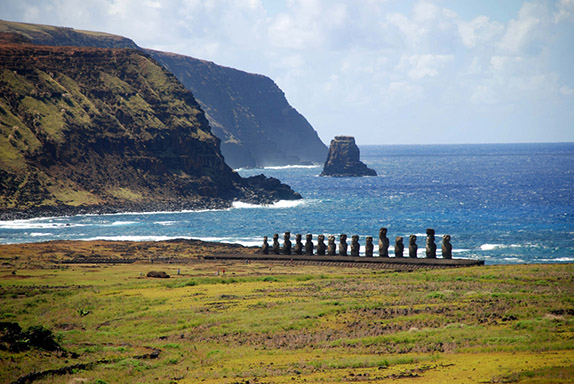 (Rapa Nui, Ahu Tongariki seen from a distance. Images by Margaret Randall)
(Rapa Nui, Ahu Tongariki seen from a distance. Images by Margaret Randall)
No one contests this argument. Water, today as it was in ancient times, is the one resource from which all others flow. Where I differ from, even take offense at, the contemporary experts’ line of reasoning, is where and how they place responsibility in our ancestors’ stories. So many articles and books seem to blame our forebears for the slow death or rapid destruction of their civilizations. In this vein they write what they hope will be seen as parables for us today. I say our ancestors did the best they could. Today we know much more, and when you know more you can do better.
Except it seems we are proving that isn’t true.
I first started thinking about this, in very dramatic terms, in 2007 when I traveled to Rapa Nui, commonly known as Easter Island. I often read the New York Times travel section, and devoured a lead article by the playwright Edward Albee. Albee had just returned from the 10 by 15-mile triangle in the middle of the south central Pacific, and the trip had changed his life. Reading of his discovery and emotion, I talked my partner and a close friend, both visual artists, into making the journey. I mention that they are both artists and I am primarily a poet, so readers will understand that our own creative sensibilities shaped my observations; and that I write in that vein, not as a scientist or expert in any of the disciplines that generally produce this sort of commentary. These lines are rooted in intuition, not scientific reason. But I don’t believe intuition is contrary to reason.
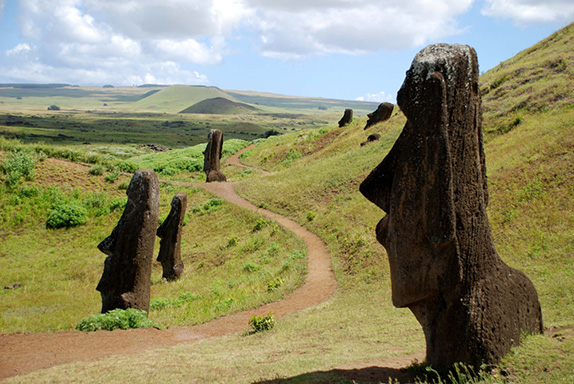 (Flank of Rano Raraku crater, with smattering of standing Moai)
(Flank of Rano Raraku crater, with smattering of standing Moai)
Before our trip, I read what I could find about the people believed to have populated Rapa Nui. Where did they come from? What brought them to that tiny slip of land? What induce them to stay? What was their culture like? And yes, how over a period of several hundred years were they reduced to mere dozens, only to be able to rise and flourish again, albeit with the problems common to all island cultures. Sadly, the original inhabitants of Rapa Nui had no written language, at least none decipherable today. Records of their tragedies and triumphs are only available to us filtered through the eyes of European explorers, evangelizing priests, and the Chileans who have claimed ownership of the colony. Questions and answers alike come to us through prisms that do not—cannot—take into account the forces that shaped them or what they believed.
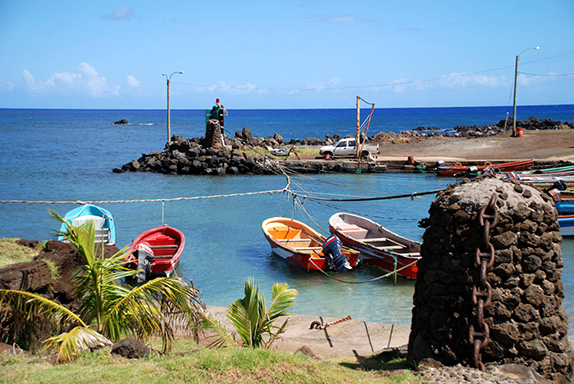 (Hanga Roa caleta or harbor)
(Hanga Roa caleta or harbor)
I read Thor Heyerdahl, the Norwegian adventurer who (erroneously) thought the people who settled Rapa Nui had come from the coast of Peru. In 1955, he made a trip in a reed boat that proved such a voyage had been possible; and in his mind if it was possible, it happened. I read Mrs. Katherine Routledge’s much earlier description of her 1914 expedition to the island, and the careful notes she kept during her stay of more than a year. In surprising ways, Routledge defied the colonialist mentality of her time and place; I found her observations original and moving. I got ahold of Alfred Metraux’ out of print but definitive treatise from the mid twentieth century. And I read Jared Diamond and others like him, who much more recently dedicate themselves to explaining why they believe past societies did themselves in.
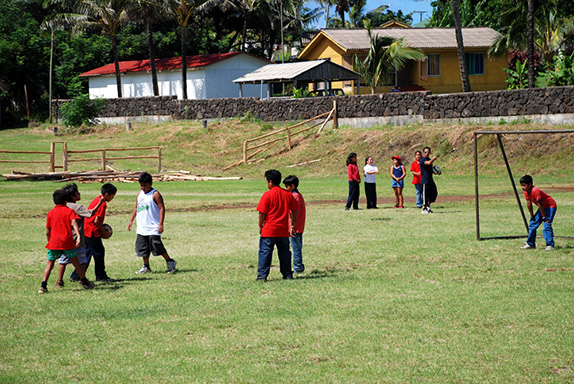 (Children playing soccer, Hanga Roa)
(Children playing soccer, Hanga Roa)
In one of his best-known books, Collapse: How Societies Choose to Fail or Succeed (his use of the word choose reveals the author’s point of view), Diamond devotes a 40-page chapter to Easter Island and returns to its “lessons” again and again throughout the volume. He also looks at the Anasazi, the Maya, the Vikings, and other peoples who developed complex cultures and then departed, imploded, or moved elsewhere.
In his assessment of Rapa Nui, Diamond is concerned with the deforestation that so clearly narrowed the islanders’ possibilities of survival. “What did the Easter Islander who cut down the last palm tree say while he was doing it? Like modern loggers, did he shout ‘Jobs, not trees!’ Or: ‘Technology will solve our problems, never fear, we’ll find a substitute for wood’? Or: ‘We don’t have proof that there aren’t palms somewhere else on Easter, we need more research, your proposed ban on logging is premature and driven by fear-mongering?’” After these glib questions he adds: “Similar questions arise for every society that has inadvertently damaged its environment.”
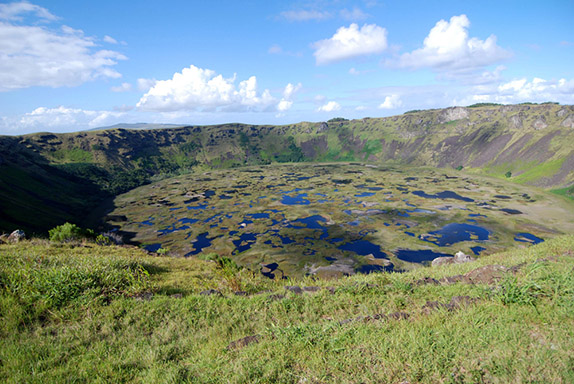 (Orongo Crater)
(Orongo Crater)
Although Diamond himself admits, a few pages later, that his metaphor is imperfect, he continues to draw such comparisons and conclusions throughout his book. My poet’s intuition and multidisciplinary curiosity cause me to view such statements with reserve at best. At worst, I find myself railing against them. I knew a brief visit to the mythical island wouldn’t provide me with conclusive answers, but I hoped it would allow me to think about alternatives, imagine myself in another time, and dream other scenarios. Even if I came up with one huge question mark, I knew I would find that question mark more intriguing and satisfying then the explanations of scholars who find it so difficult to escape the limitations of their own cultural assumptions.
It was a long trip from Albuquerque to Rapa Nui. We might have traveled south through Chile (also a long trip), but I chose to reduce the cost by flying west to California and Tahiti, and then east again to our destination. After three full days, I looked out my window on the plane, and took in the entire island. I could see we were approaching an unusually long runway, and later learned it does in fact dwarf the island on which it sits. It was built as an alternative landing spot for the space shuttle. Surprisingly, after such extensive travel west and then east again, I realized Rapa Nui lay in our very own time zone; clocks there were set to the same hour as Albuquerque.
Hanga Roa is Rapa Nui’s only settlement. In fact, it is illegal to build outside the small community as the rest of the island is protected as a national park. In the village, a very few paved roads and several more earthen lanes meandered past a dozen hotels and guest houses, a smattering of restaurants and curio shops, a couple of churches, a museum, and a single gas station. Horses and dogs roved freely. People were friendly and accommodating. Tourism was important. I sensed a palpable pride of heritage. Polynesian origin mixed with Chilean occupation. Almost everyone spoke Spanish; I was told the original south Pacific language was known only by the older generation. Many of the younger had studied in Chile, and returned to use their education to help preserve and intelligently develop what they know is an exceptionally unique place.
 (Petroglyphs at Orongo)
(Petroglyphs at Orongo)
We had booked a room in advance at one of the small hotels, and that very afternoon joined a half-day tour that seemed like it might give us an idea about what it was possible to see. We quickly realized this had been a mistake. I’d read enough that I knew our guide’s spiel was rote as well as superficial. So we asked the hotelier where we could rent a car. He said his cousin had a jeep that might do. From then on we were on our own. With a single road circling the island, one could hardly get lost. There was a great deal to see, and we wanted to see as much of it as possible.
 (Berm houses built by the Birdman Cult at Orongo)
(Berm houses built by the Birdman Cult at Orongo)
And we wanted to be free to take it in at our own pace, to climb into the quarry where the giant moai had been cut from the rock and where many of the great figures remained half alive. We wanted to wander among the statues, imagining our own solutions to the question of how human beings without discernible use of the wheel had moved those that weighed many tons from their points of origin to the shore. We wanted to invent our own reasons for why they all stood in solemn lines, looking landward with their backs to the sea. What we really wanted, and knew would be impossible to obtain, was a sense of what it was like to live on Rapa Nui many centuries ago.
We wandered and picnicked and sat in silence. We wrote and drew and photographed. And we finally came home, knowing we would never have the answers to these questions but feeling we had tapped into some great collective memory, its fragments holding us in place.
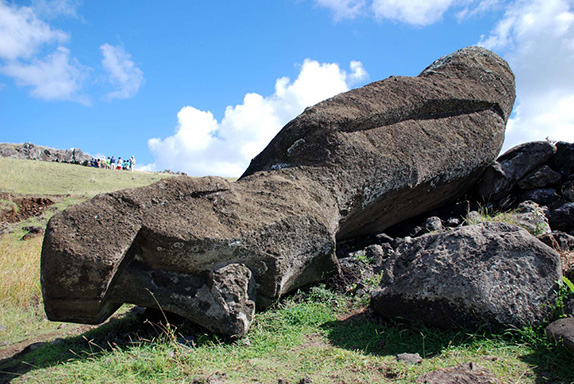 (Fallen Moai)
(Fallen Moai)
I eventually wrote a book—poems and photographs—rooted in Rapa Nui’s magic. And I discovered the work of Shawn McLaughlin. To date, his Complete Guide to Easter Island, is the most comprehensive guidebook to Rapa Nui. But it is much more than that. It goes beyond the typical handbook to explore social and cultural issues, even some of the scientific questions still plaguing Rapa Nui scholars. After our trip, I got in touch with McLaughlin. A rich correspondence ensued. I learned a lot, all of which reinforced my irritation with those who project 21st century assumptions when attempting to decipher the problems faced by peoples many centuries before.
The point is: all peoples want to live in health and happiness. Whatever their century or culture. And all peoples do the best they can to insure their survival. The original inhabitants of Rapa Nui settled a tiny island with what some experts say were a million palm trees. They cut the trees down to build homes and boats, until none were left. Although they were as adept as any at learning from their environment, and managed to make a lot of what they had, they didn’t have a lot of science. They relied on their spiritual beliefs.
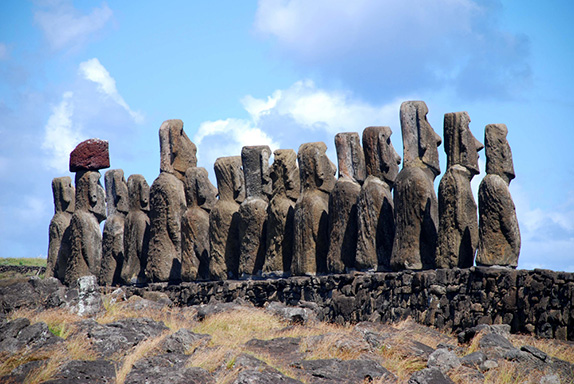 (Moai on Ahu Tongariki)
(Moai on Ahu Tongariki)
We really don’t know what those beliefs were any more than we know what the beliefs of the Anasazi or other ancient peoples were. We have clues, garnered from the studies made by hundreds or thousands of specialists, each with his or her own way of understanding the world, who may or may not share information with one another and are often proven wrong as subsequent discoveries unfold. We can only really know what life was like for others if we were one of them.
Ancient peoples wanted to live as much as we do. I’m sure they wanted to leave a better world to their children, just as is true of most of us. They had their spiritual beliefs and the limited experience passed down from generation to generation. They didn’t have the benefit of specialized scholarship, being able to draw on the experiences of other societies in other parts of the world, the Internet or any of the many tools that provide us the interconnected panorama we have today.
We have it all. Our spiritual beliefs and our science. The advantage of hindsight, not only our own but what the multidisciplinary study of so many societies tell us. We know we cannot live without our natural resources, but do nothing to conserve them—except as individuals when we all know governmental and corporate solutions are the real answer.
We know our water tables are going down, yet we continue the insane overdevelopment that will only deplete them further. This is particularly evident in our own Southwest. We know what climate change and global warming is doing to our planet, yet cannot come together to deal with the problems they already create. We know the horror and devastation of war, yet we continue to make more wars. And the obscene amounts of money we spend on those wars would go a long way toward solving the existential problems we face.
Perhaps it is time we stop blaming ancient peoples for their demise, and begin exercising responsibility for solving today’s problems. We neither live on an isolated island, nor do we lack the knowledge or solutions.




Responses to “We have it all”